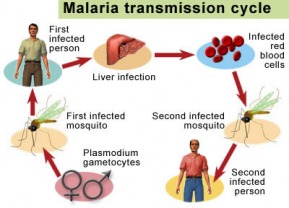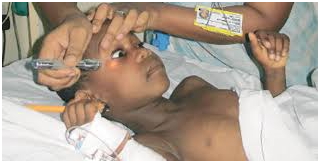Definition:
Malaria is a contagious parasitic disease caused by a parasitic organism called plasmodium and transmitted by mosquito bites. There are 5 parasite species that cause malaria in humans, and 2 of these species – P. falciparum and P. vivax – pose the greatest threat. P. falciparum is the most prevalent malaria parasite on the African continent. It is responsible for most malaria-related deaths globally. P. vivax is the dominant malaria parasite in most countries outside of sub-Saharan Africa, these species are mostly found in Asia, causing less acute symptoms, however, the parasite remains in the liver and causes setbacks for up to four years.
Causes:
The disease is caused by the malaria parasite (plasmodium) which is transmitted by an infected female Anopheles mosquito from the infected person to the healthy person.
Other ways of transmitting the disease:
Pregnant woman may transmit the disease to her fetus. It is also transmitted through blood transfusion.
 Risk Factors:
Risk Factors:- Rain and increased water bodies are appropriate for mosquito breeding and disease transmission.
- Young children and infants.
- Pregnant women.
- People with weak immunity are more susceptible to the risk of malaria.
- People travelling to malaria infected areas.
- Poverty and lack of health awareness and education contributes to spreading the disease and increasing mortality rate around the world.
Symptoms:
Malaria is an acute febrile illness. In a non-immune individual, symptoms usually appear after seven days or more (10–15 days in most times) after the infective mosquito bite. The first symptoms may include:
Fever, headache, shivering, diarrhea, coughing and anemia. If not treated within 24 hours, P. falciparum malaria can progress to severe illness, often leading to death. and chills– may be mild and difficult to recognize as malaria. If not treated within 24 hours, P. falciparum malaria can progress to severe illness, often leading to death.
Children with severe malaria frequently develop one or more of the following symptoms: severe anemia, respiratory distress in relation to metabolic acidosis, or cerebral malaria. In adults, multi-organ involvement is also frequent. In malaria endemic areas, people may develop partial immunity, allowing asymptomatic infections to occur.

Diagnosis
Early diagnosis and treatment of malaria reduces disease and prevents deaths. It also contributes to reducing malaria transmission.
Patient History and Clinical Examination:
When the symptoms of malaria appear, the doctor will examine a sample of your blood under a microscope. Two samples of blood will be taken at intervals of 6-12 hours to confirm the presence and type of malaria parasite and all cases of suspected malaria through diagnosis confirming existence of the parasite (either by microscopy or rapid diagnostic test).
Complications:
Most serious complications of malaria are associated with parasite "falciparum" infection, among the complications that may occur are:
- Anemia.
- Cerebral malaria.
Other potential complications:
- Respiratory distress, sometimes is acute due to accumulation of fluids in the lung.
- Dryness.
- Liver failure.
- Kidney failure.
- Splenomegaly.
- Cramps.
- Fainting.
- Death.
Treatment:
Malaria, specially caused by P. falciparum requires immediate and prompt treatment, and in most cases doctors can effectively treat malaria with one or more of the following medicines:
Treatment of uncomplicated malaria (falciparum):
Artesunate (AS) + Sulfadoxine-Pyrimethamine (SP) + Primaquine Tab. (Single dose) Artemether-lumefantrine (Coartem) + Primaquine Tab. (Single dose)
Treatment of complicated malaria (falciparum):
Parenteral ARTESUNATE (I.V)
Parenteral ARTEMETHER (I.M)
Quinine (I.V)
Treatment of (Vivax):
Tablet Primaquine + Chloroquine
Prevention:
Preventive treatment:
In case you have to travel to malaria-affected areas you must take the prescribed preventive dose one to two weeks before traveling, and during your stay in those areas, and for four weeks after returning. Vector control is the main way to reduce the spread of malaria at the community level. It represents the only intervention capable of reducing transmission of the disease from very high levels to around zero levels. For individuals, personal protection against mosquito bites represents the first line of defense for disease prevention.
There are two main types of vector control intervention, which are effective in different environmental circumstances, they are:
- Insecticide-treated mosquito nets.
- Indoor spraying with residual insecticides.
There are some other ways of prevention, including:
- Using mosquito repellent.
- Using mosquito repellent paint on exposed skin, or by spraying insecticide to kill mosquito specially at sleeping areas. Do not use the paint on young children or infants of less than two months.
- Concentration of the pesticide depends on the hours of protection, a high concentration of 50% gives longer hours of protection, while the pesticide which its concentration reaches only 10% provides protection of only 2 hours.
- Wearing protective clothing during activity times of mosquito, usually between dusk and dawn, like trousers and shirts with long sleeves, putting repellent paint on clothes and shoes before traveling, you may also buy treated clothes and using caps to protect face and neck.
- Using long-lasting insecticidal nets (LLINs), if the place you stayed in has no air conditioning or mosquito repellent, and you must sleep under treated mosquito nets.
- Filling ponds and getting rid of mosquito breeding sites contributes to prevention of malaria and limit its spread.
